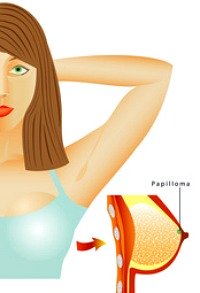Breast Papilloma and Breastfeeding

Breast papilloma is a benign growth inside a milk duct. In many cases several papillomas are grouped together.
Duct papilloma causes a clear or bloody discharge from the nipple. It is usually accompanied by breast pain.
Duct papillomas are mostly found in women older than 35. So if you are breastfeeding and are under 35, chances are something else is causing bleeding and breast pain.
Several other conditions may have similar symptoms. Check them out before thinking of a breast papilloma:
- Bleeding may start during the first weeks of nursing. While the ducts are getting adjusted to holding milk supply, some sores are common. Such minor bleeding goes away within a couple of days.
- Also check your nipples. Blood may not even be coming from inside your breasts. It may be coming from cracked or sore nipples.
- Bleeding and other unusual discharge from the nipple may also result from an abscess.
- Breastfeeding breast pain by itself has many other possible reasons, for example engorgement and oversupply - to name a few. Check out this list of 17 causes of breast pain.
How to Diagnose
If bleeding and pain persist, do a breast self-exam. Papillomas usually grow in the duct area close to the nipple. Multiple papillomas form a small lump that is easy to feel under the nipple or areola.
Single papilloma can’t be felt. If bleeding and pain persist, but you can’t feel anything, talk to your OBGYN.
Papillomas can grow on just one or both breasts. Don’t make your diagnosis based on whether one or both breasts are bleeding.
Multiple papillomas grouped together may block the duct. In this case bleeding and pain are accompanied by symptoms of a clogged milk duct.
Multiple papillomas and the ones with abnormal (still not cancerous) cells slightly increase the risk of breast cancer.
Papillomas are usually removed by means of biopsy or surgery. Affected duct may also need to be removed.
Important: With a vast array of conditions that cause similar symptoms, it is best to see a doctor upon the occurrence of any of them.
Is It Safe to Breastfeed?
It is safe to breastfeed a baby while having a papilloma. It is also safe to breastfeed while there is blood in your milk.
Papilloma removal doesn’t jeopardize breastfeeding. Even if the affected duct is removed, you can still exclusively breastfeed and have a good milk supply.
There are many ways to show your love and devotion to your kids and to win their trust. Breastfeeding is the most natural one.
Yours,
Viktoriya
Home › Breastfeeding Problems › Breast Papilloma










